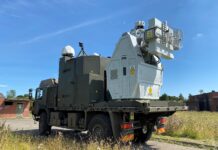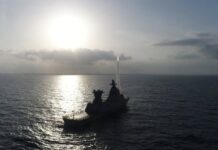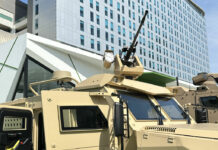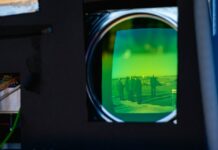Once the stuff of science fiction, directed energy weapons (DEWs) are now becoming a reality, as research, development, trials and funding advance their progress towards maturation for fielding on land, at sea and in the air.
A type of electromagnetic (EM), or particle technology, which uses energy, as opposed to a solid projectile, to strike a target, DEWs have been under development for many decades. Defence establishments and government agencies around the globe have been considering the potential for these systems to transform strategic and tactical approaches on the field of battle and how they might offer new options to counter emerging threats. However, despite early enthusiasm and research around the technology, progress has faced many technical and operational challenges. Nevertheless, the increasing electrification of the battlespace and tech advances are just some of the factors giving greater impetus to DEW efforts, although current approaches to military systems power specification, generation and delivery still need radical change, otherwise these systems may continue to be held back. That said, being able to disrupt, degrade, or damage a target by emitting highly focused EM energy, either in the form of a beam laser light, concentrated radio frequency (RF), microwaves, or using other directed energy, means such systems could have multiple applications on the battlefield, from airborne platform protection to ground-based air defence, including, just as one critical example, to defeat swarming attack drones.
For the defence industry, several leading defence companies such as Lockheed Martin, Raytheon, MBDA, Rheinmetall, Thales, QinetiQ, to name just a few alongside many others, have been working in the field of directed energy systems and weapons for decades and have been working closely with partners and national defence establishments. Systems have been trialled, and projects have come and gone. Rather than looking back, however, this article takes a look at some of the current thought, research and operational thinking around DEWs, as well as at recent developments for their application in the airborne environment.

Credit: QinetiQ
Technology Scene Setting
A catch-all term that encompasses several different complex tech under one umbrella, directed energy weapon technologies are at different levels of maturity, each with its own important distinctions from the others. Fundamentally, three main systems fall under the DEW term. The first, High Energy Laser (HEL)-based systems, includes different types of lasers, with chemical, solid-state and free-electron lasers the most relevant. While invented back in the 1960s, the main obstacle to the development and uptake of laser weapons has been the energy required to power them, which is where the greater electrification of the battlespace may play its part in changing this. Of the different laser types, chemical lasers are the most mature, but suffer from a number of impracticalities, not least of which is their use of hazardous substances. Safer in this regard, the laser weapon systems starting to be fielded are solid-state, or fibre lasers (being advanced by AFRL, see below), while the third kind, free-electron lasers, are the most recent discovery, and the least-developed for weapon use as a result.
The second kind of technology falling under the DEW term is based on the use of focused radio frequency (RF) waves, including high-powered microwaves (HPM). Widely used in high-powered mobile and telecommunications networks, this technology is more mature than laser-based systems and is already operational.
Lastly, particle beam systems – the least mature tech of the three – unlike the others, fire atomic and sub-atomic particles at a target, either as charged or neutral particles. The latter holds particular interest for space-based systems as they can be used outside the atmosphere.
Applying the Tech
As for which technology to apply to which defence application, that’s based not only on technological challenges, but also on the different effects each has on a target and whether a lethal or non-lethal effect is required. HELs and particle beam systems, for example, can disrupt and destroy equipment, whereas the effects of low-power lasers on equipment such as optoelectronic sensors, including those on satellites, as well as pilot vision is simply to dazzle the target and to achieve a desired result in that non-lethal fashion. High-power microwaves can also degrade and damage electronics, command post computer and communications systems and have also been effective against UAV platforms. As for millimetre waves, these have been tested as anti-personnel area denial weapons, where they create burning, though non-lethal, sensations on the skin.
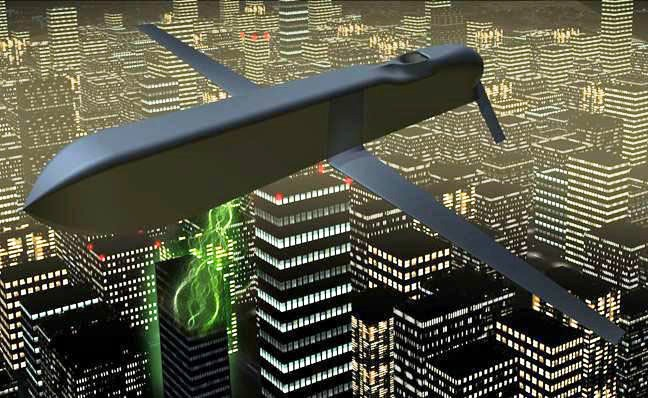
Credit: US AFRL
Given their low operational cost per shot, (each of which travels much faster than rounds from conventional weapon systems and remains unaffected by gravity ‘during flight’), as well as their ability to launch silent and invisible (to the naked eye) attacks, DEWs are an increasingly attractive prospect for military inventories. Trying to locate the source from which a DEW attack has come, such as an RF attack using high-powered microwaves, for example, can be difficult without specialised equipment. Such RF tech may be that behind ‘Havana syndrome’ – tied to relatively recent documented ‘events’ at overseas US diplomatic missions, when numerous diplomats and staff became ill with lasting neurological and audiological symptoms, due likely to an unidentified directed energy weapon system.
Yet, DEWs are not without their operational limitations. The effect of a high-power laser on a target, for example, is not an immediate one, as would be the case using a conventional weapon; a laser effect is cumulative, its energy on target requiring several seconds before damage and/or destruction occurs. And while a conventional artillery round, for instance, will be affected to some degree by weather conditions, they can still fire and hit a target under such conditions, whereas the impact of rain, cloud or fog on a laser will be to attenuate the beam to the point where it cannot be used. The system needs line of sight and if the target is obscured a laser will be unable to see its target. RF systems, too, can be affected by weather conditions.
Powering such systems remains a challenge. Power constraints mean that the highest-power DEWs are most suited for mounting on ships, and their employment of land vehicles typically involves some level of compromise. For effective deployment of such weapon systems, regardless of size, a revolution in the way energy is stored and delivered is needed; compact, ultra-high-power batteries are just one of the needs that will help ensure the right amount of power is delivered to a laser, for example, where and when it’s needed.
Air Force Research Lab
At this time, whereas particle-beam weapons are merely a distant, future prospect, it is the low-powered lasers and radio frequency-based systems, which are much more frequently used in the field. HELs have now reaching the levels of technological maturity they need for operational use on land, sea or air platforms, including for airborne applications. Indeed, the US Air Force Research Laboratory (AFRL) underscores how laser weapons, in general, already offer operatives unique opportunities for quick and precise target engagement, highlighting such laser capabilities such as speed-of-light delivery, multiple target engagements and rapid retargeting, deep ‘magazines’, their exceptional accuracy and adjustability, lower logistical support requirements and low incremental cost per shot, as some of their outstanding properties. For its part, the AFRL is one of those establishments alluded to above that is working with the USAF and other DoD partners and industry to bring high energy laser weapons to the field. The lab is rapidly maturing fibre-laser-beam combining capabilities, where larger numbers of fibre laser amplifiers are combined into a single beam; it has made significant progress in this regard, increasing the output power of individual fibre laser amplifiers. Through beam combining, single amplifier improvements result in enormous power scaling and AFRL is actively transitioning this and other key technology elements to strategic DoD entities and prime contractors for use in advanced technology demonstrations, including for airborne DEW/laser weapon system (LWS) applications.
The AFRL is also working on high-power microwaves which it sees as offering the military innovative technologies that enable a variety of low-collateral-damage military applications, including enabling users to achieve counter-electronic effects, to counter improvised explosive devices, and also to counter weapons of mass destruction. The AFRL believes that in the not-too-distant future, focused beams of microwave energy will be used defensively to protect planes and ships against incoming missiles, and offensively to attack militarily important electronic targets, including from the air aboard UAVs and other airborne platforms. These beams will emanate from sophisticated compact devices that convert a modest quantity of stored electrical energy into high-power bursts that have the capacity to penetrate structures and disrupt delicate electronic devices that reside within. This vision of modern directed energy warfare is enabled by revolutionary high-power electromagnet (HPEM) advances made in the recent past and by additional, anticipated advances.

Credit: Lockheed Martin
Industry Snapshot
While many leading players, as mentioned above, are active in this space, one industry player we’ll look at briefly here with airborne projects underway, is Lockheed Martin, which is currently undertaking its Tactical Airborne Laser Weapon System (TALWS) programme. This is aimed at developing mature and producible tactical airborne laser weapon solutions, which complement kinetic defences to protect land, sea, and aerial assets. With over 40 years of R&D experience in this field, including with beam-control tech, its current developments ‘under contract’ today can defeat small rockets, UAVs, small attack boats, and lightweight ground vehicles. Yet it’s with the US Government that the company is a core member of the industry team for the USAF’s Self-Protect High Energy Laser Demonstrator (SHiELD) system, developing critical components of an airborne laser pod, including the high-energy laser and other sub-systems that will be demonstrated ahead of a programme of record in the mid-2020s. This is alongside its land and sea-based programmes.
As part of the company’s research for both SHiELD and other projects, it’s working with partners, DoD and government establishments to develop producible, low-cost, tactical beam directors — the optical system that puts high-energy light on-target and keeps it there with high precision to ensure the desired target effect is achieved and the threat defeated. The DoD’s investment in acquisition and tracking technologies over the years is contributing here to the development of LWS-specific algorithms that enable the beam director to detect, identify, track and defeat threats. While it will be adapted for both airborne and maritime applications, the current stage of beam director development, comprising a gimballed beam director assembly and an acquisition and tracking system, will first be demonstrated in a ground application for the US Army. Maturation of these beam director lab developments for use in the field is something Lockheed Martin is striving to achieve so full-rate production can take place as soon as possible.
In the meantime, development work is underway on an airborne laser pod solution that supports a rapid transition to production and deployment—and ultimately, a transition to embedded systems. Some critical components, for example, such as optics that can handle high-energy laser beams, have only been built in very small quantities for prototypes and so capital investment in expansions to produce such components for the airborne pods at full production rates and at lower cost, are underway, to ensure the USAF receives its tactical airborne laser pods when required.
In another project, in October of 2021, the company delivered its Airborne High Energy Laser (AHEL) to the USAF for flight testing on an AC-130J aircraft. This followed successful completion of factory acceptance testing for the AHEL in preparation for US military ground and flight testing of the system and follows on from the January 2019 contract award to the company for integration, test and demonstration of the laser weapon system aboard the AC-130J. The programme is now on a rapid schedule to continue testing this capability. VP Lockheed Martin Advanced Product Solutions, Rick Cordaro, said at the time that the company’s partnership with the USAF was rapidly achieving important advances in laser weapon system development, demonstrated by the field-test-ready system at that time. The company is also now halfway through a cost-plus-fixed fee, indefinite-delivery, five-year contract award, (awarded mid-July 2021), for technical services, integration, test, and demonstration for the AHEL system for the USN’s Naval Surface Warfare Centre, Dahlgren Division.
DoD Airborne Laser Interest for BMD
In the area of ballistic missile defence (BMD) the US DoD’s latest Missile Defence Review (MDR) noted the importance and potential for laser weapon systems to play a part in BMD.
The review noted that the interception of offensive missiles in their boost phase, (i.e. before the re-entry vehicle separates from the booster), using kinetic interceptors and/or directed energy would increase the likelihood of successfully countering a threat by reducing the number of mid-course or terminal active defence interceptors needed to destroy an adversary’s remaining offensive missiles. It would also help complicate an aggressor’s attack calculus by reducing its confidence in its missile attack planning and likelihood of success.
The DoD’s MDR also stated that developing scalable, efficient, and compact HEL technology and integrating it onto an airborne platform holds the potential to provide a future, cost-effective capability to destroy boosting missiles even in the early part of their trajectory, which is the most difficult phase of flight (due to both distance and the short time window for reaction), in which to take down a ballistic missile. Doing so would leverage technological advances made previously in the DoD’s Airborne Laser Programme, including, for example, advances in beam propagation and beam control. The Missile Defence Agency (MDA) is developing a low-power laser demonstrator to evaluate the technologies necessary for mounting a laser on an unmanned airborne platform to track and destroy missiles in their boost-phase. The DoD has a strategic roadmap for the development and fielding of directed energy weapons and key enabling capabilities aimed at informing high-energy laser investments in the future.
Tim Guest





![Pilots for soldiers A US Soldier assigned to 2nd Brigade Combat Team, 101st Airborne Division operates the Kraken during exercise Spectrum Blitz 25 at the Hohenfels Training Area, Germany, on 11 April 2025. [US Army/Sgt Collin Mackall]](https://euro-sd.com/wp-content/uploads/2025/09/Spectrum-Blitz-25-US-ArmySgt-Collin-Mackall-Kopie-218x150.jpg)
![Doing everything at once This image gives a good indication of how many RF antennas a modern combat aircraft must have; these are just for the plane’s electronic warfare system. [BEL]](https://euro-sd.com/wp-content/uploads/2025/09/BEL-EW-Suite-Antennas-BEL-Kopie-218x150.jpg)
